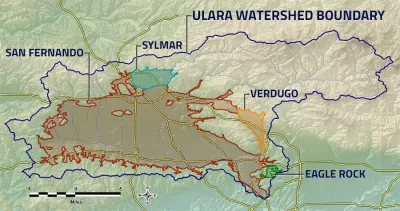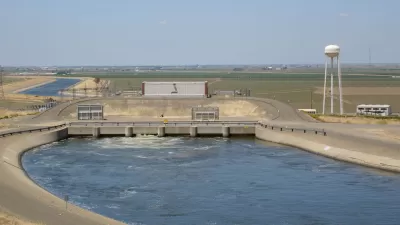The semi-arid region of Los Angeles is often mistaken for a desert, but the local water supply is also constrained by the environmental sins of the 20th century. The water supply equation of Los Angeles will soon change, however.

Hayley Smith reports for the Los Angeles Times on a major breakthrough for resilience in the nation’s second largest city: the city of Los Angeles is nearing completion on a $600 million project to restore groundwater supplies in the San Fernando Valley.
“Nearly 70% of the city’s 115 wells in the San Fernando Valley groundwater basin — the largest such basin under the purview of the Los Angeles Department of Water and Power — have been sitting unused for decades after dangerous contaminants seeped into the aquifer,” explains Smith.
The toxic plume in the city’s groundwater supply is a result of pollution from the aerospace, automobile, and defense industries of the region’s boom period in the 20th century. “The extent of the problem wasn’t fully uncovered until after the Safe Drinking Water Act of 1974 mandated increased testing and monitoring standards for drinking water,” according to the article.
The project will enable three treatment facilities to filter contaminants from the toxic plume out of the groundwater basin. Angelenos will “regain full access to up to 87,000 acre-feet of water each year, or nearly a fifth of what they consume.”
The new water supply couldn’t come at a better time, as the state and the region attempt to address the latest of a string of droughts—a trend only likely to worsen as a result of climate change. The long-term work of retrofitting the valley with permeable surfaces is not mentioned in the article.
FULL STORY: Drought-ravaged L.A. seeks surprising source of water: A contaminated Superfund site

Maui's Vacation Rental Debate Turns Ugly
Verbal attacks, misinformation campaigns and fistfights plague a high-stakes debate to convert thousands of vacation rentals into long-term housing.

Planetizen Federal Action Tracker
A weekly monitor of how Trump’s orders and actions are impacting planners and planning in America.

In Urban Planning, AI Prompting Could be the New Design Thinking
Creativity has long been key to great urban design. What if we see AI as our new creative partner?

King County Supportive Housing Program Offers Hope for Unhoused Residents
The county is taking a ‘Housing First’ approach that prioritizes getting people into housing, then offering wraparound supportive services.

Researchers Use AI to Get Clearer Picture of US Housing
Analysts are using artificial intelligence to supercharge their research by allowing them to comb through data faster. Though these AI tools can be error prone, they save time and housing researchers are optimistic about the future.

Making Shared Micromobility More Inclusive
Cities and shared mobility system operators can do more to include people with disabilities in planning and operations, per a new report.
Urban Design for Planners 1: Software Tools
This six-course series explores essential urban design concepts using open source software and equips planners with the tools they need to participate fully in the urban design process.
Planning for Universal Design
Learn the tools for implementing Universal Design in planning regulations.
planning NEXT
Appalachian Highlands Housing Partners
Mpact (founded as Rail~Volution)
City of Camden Redevelopment Agency
City of Astoria
City of Portland
City of Laramie





























